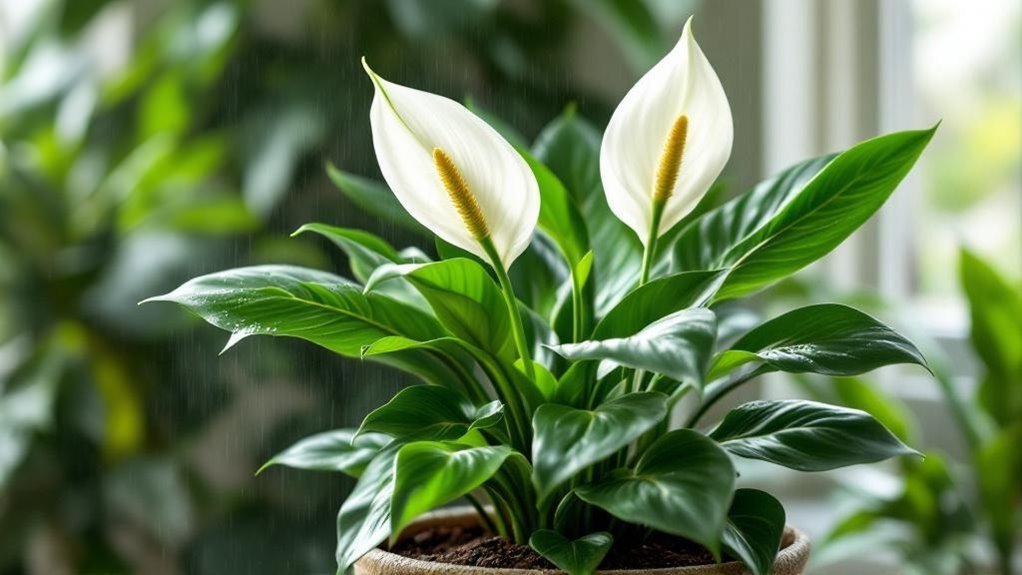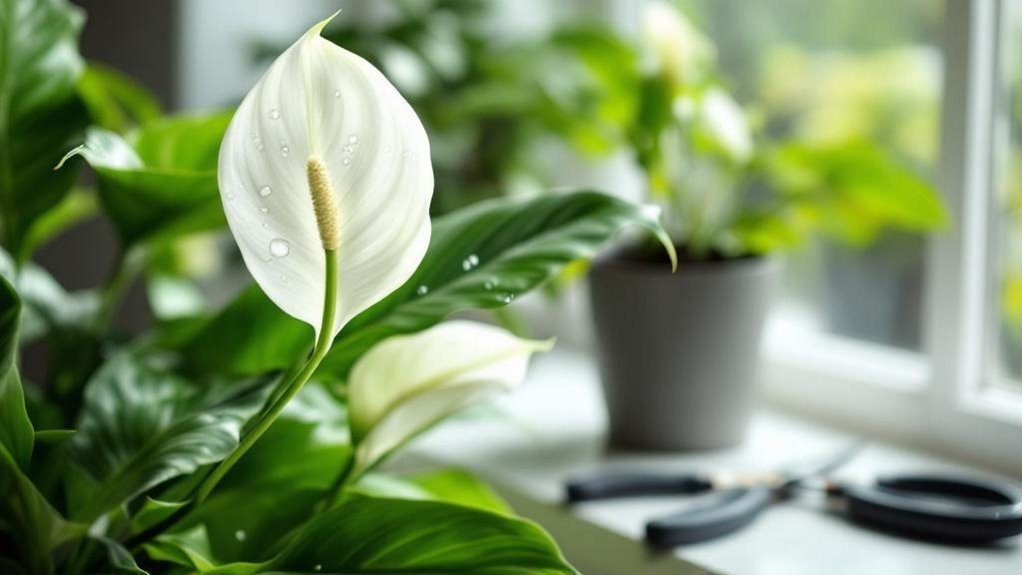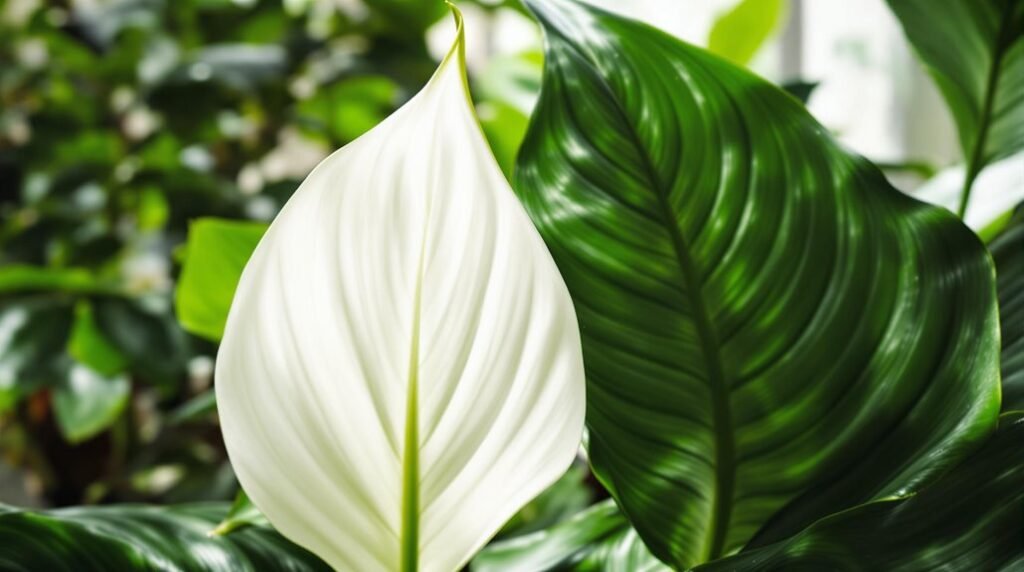You might not realize that peace lilies can bloom indoors year-round if cared for correctly. Getting the light, water, and humidity just right is more nuanced than most people think. If you want your plant to thrive rather than simply survive, you’ll need to understand its specific needs and how to manage common care challenges. Let’s explore what it really takes to keep your peace lily healthy and vibrant.
Understanding Peace Lily Characteristics
Peace lilies, or Spathiphyllum, are tropical evergreens that thrive in shaded, humid environments like those found in Central and South American rainforests.
As tropical plants, they showcase glossy dark green leaves with a fish-bone pattern and elegant white flowers that bloom mainly during the growing season but can appear year-round if conditions are right.
You’ll appreciate their air-purifying qualities, as they help remove toxins like carbon monoxide and formaldehyde from your indoor air.
Keep in mind, peace lilies are mildly toxic due to calcium oxalate, so handle with care if you have pets or children.
Handle peace lilies carefully—they contain calcium oxalate and can be harmful to pets and children.
These plants flourish in humidity and dappled sunlight, mimicking their native habitat’s gentle shade and moisture, making them both beautiful and functional additions to your home.
Ideal Light and Temperature Conditions
To keep your peace lily healthy and blooming, pay close attention to its light and temperature needs. Your peace lily thrives best under bright indirect light, so avoid direct sunlight that can scorch its leaves. It tolerates lower light conditions but may bloom less, so gradually increase exposure to encourage flowering.
- Place near an east-facing window for ideal light without leaf burn.
- West-facing windows work if filtered light is provided.
- Maintain the perfect temperature range between 65°F and 80°F (18°C–27°C).
- Protect from cold drafts and temperatures below 50°F (10°C) to prevent stress.
Consistent warmth and proper light will keep your peace lily growing strong and blossoming beautifully.
Watering and Humidity Requirements

Although they can handle short dry spells, your peace lily will thrive best when you water it once the top inch of soil feels dry, usually about once a week during the growing season.
Keep the soil consistently moist but avoid overwatering, which can cause yellow leaves and root rot. Make sure your pot has drainage holes to prevent standing water.
To maintain the right humidity, misting the leaves regularly or placing the plant on a pebble tray filled with water helps, as peace lilies prefer high humidity.
Remember, the ideal temperature range for your peace lily is between 65°F to 80°F (18°C to 27°C), so keep it away from cold drafts that might stress the plant.
Proper watering and humidity are key for healthy growth.
Soil, Repotting, and Propagation Techniques
When your plant starts showing roots through the drainage holes or on the soil surface, it’s time to repot it into a container 1-2 inches larger in diameter.
Use well-draining, all-purpose potting soil that includes peat moss or perlite for proper moisture retention and aeration.
During repotting, consider propagation by division—separate clumps ensuring each has roots and leaves.
Follow these steps for healthy growth:
- Remove the plant gently from its pot and loosen the roots.
- Inspect and trim any damaged roots.
- Divide the root ball into sections if propagating.
- Place the plant in fresh soil within the new container, ensuring good drainage.
Regularly flush the soil to prevent salt buildup and maintain ideal soil conditions for your peace lily’s growth.
Fertilizing and Pruning Practices

Since peace lilies thrive with proper nutrition and care, you should fertilize them every six weeks during the growing season using a balanced, water-soluble fertilizer diluted to half strength. This promotes healthy growth and blooming without risking root burn.
Avoid fertilizing in fall and winter when your plant is dormant to prevent brown tips and damage. Regular pruning is equally important—remove yellow leaves, brown tips, and spent blooms with clean, sharp scissors to encourage new growth and maintain your plant’s appearance.
Watch for signs of over-fertilization, like browning leaf tips, and flush the soil with water if needed to remove excess salts. By combining careful fertilizing and pruning, you’ll keep your peace lily vibrant and thriving year-round.
Managing Common Issues and Pests
Proper fertilizing and pruning set the foundation for a healthy peace lily, but you’ll also need to keep an eye out for common issues and pests that can affect its well-being. Here are key problems to watch for:
Fertilizing and pruning are essential, but vigilance against pests and common issues ensures a thriving peace lily.
- Brown tips often result from low humidity or over-fertilization; increase humidity and adjust watering.
- Yellowing leaves signal overwatering or poor drainage; guarantee well-draining soil and use purified water.
- Curling leaves mean too much direct sunlight; move your peace lily to a shadier spot.
- Pest infestations like scale and mealybugs require regular inspection and treatment with insecticidal soap.
Avoid overwatering to prevent root rot by letting the soil’s top layer dry before watering again.
Monitoring these signs keeps your peace lily thriving.
Safety Considerations and Toxicity Risks
Although peace lilies add beauty to your space, you should handle them with care because they contain calcium oxalate crystals that can cause mild toxicity if ingested by humans or pets.
Ingestion may lead to symptoms like stomach upset, oral irritation, and respiratory distress, so safety considerations are essential. To protect pets and small children, always keep your peace lily out of reach to prevent accidental ingestion.
Regularly clean the leaves to reduce dust and remind yourself of the plant’s toxicity. If ingestion occurs, contact a medical professional or veterinarian immediately for proper care.
Being aware of these risks guarantees you enjoy your peace lily safely without compromising the health of your loved ones or pets.
Frequently Asked Questions
How to Successfully Grow a Peace Lily?
You’ll successfully grow a peace lily by placing it in bright, indirect light, watering when the topsoil’s dry, maintaining humidity, fertilizing every six weeks, and repotting every 1-2 years with fresh, well-draining soil.
What Makes a Peace Lily Happy?
Did you know peace lilies can bloom up to twice a year? You make yours happy by giving bright, indirect light, moist soil, high humidity, warm temperatures, and occasional feeding—these care steps keep it thriving and blooming beautifully.
Should I Cut the Brown Tips off My Peace Lily?
You should cut brown tips off your Peace Lily to improve its appearance and encourage growth. Just use sterilized scissors, cut above green tissue, and address issues like low humidity or over-fertilization to prevent browning.
Do Peace Lilies Thrive Better in Soil or Water?
You want lush leaves, strong roots, and vibrant blooms. You’ll find peace lilies thrive better in soil because it offers nutrients, stability, and better moisture control, unlike water, which needs extra care to avoid root rot and nutrient deficiencies.
Final Thoughts
Caring for your peace lily isn’t rocket science—you just need to give it the right balance of light, water, and care. Keep it in bright, indirect light, maintain consistent moisture, and prune regularly to keep it looking its best. With a little attention, your peace lily will bloom like a refreshing change, brightening any room. Remember, a healthy plant reflects the love you put into it, so don’t let it slip through the cracks!
